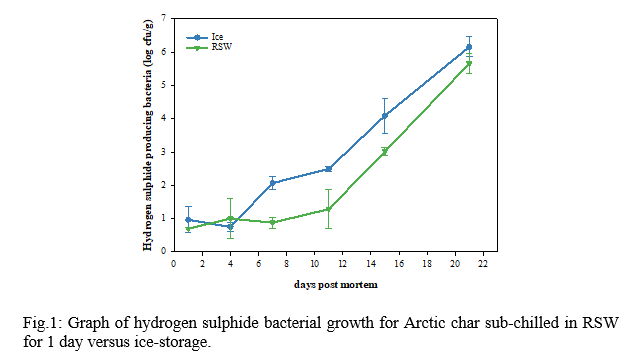SUB-CHILLING AQUACULTURE SPECIES FOR IMPROVED QUALITY AND SHELF LIFE
Introduction
Sub-chilling is a preservation method that maintains the freshness and prolongs the shelf life of seafood by reducing the temperature to between 0 °C and its initial freezing point, for instance, from -1 to -1.5 °C. This process keeps the fish in a fresh state, rather than frozen. Sub-chilling can be achieved in several ways. Refrigerated seawater (RSW) is frequently used for whole fish, while research on sub-chilled fillets often employs impingement or cryogenic freezing. In the aquaculture industry, sub-chilling fish in RSW onboard vessels immediately after slaughter by the pens allows the delivery of fish already sub-chilled at the early stages of the value chain.
Research also indicated that sub-chilling eliminates the need for ice and reduces meltwater incidence (Rotabakk et al., 2023). Consequently, more fish can be packed and maintained at sub-chilled temperatures until reaching the market, significantly reducing greenhouse gas emissions and costs (Iversen et al., 2021). This presentation provides an overview of studies on sub-chilling for various aquaculture species in Norway.
Materials and Methods
The studies collectively evaluated the effects of sub-chilling of whole fish in RSW on the quality and shelf life after processing and storage. The species studied included Atlantic salmon (Salmo salar), Atlantic halibut (Hippoglossus hippoglossus), brown trout (Salmo trutta), and Arctic char (Salvelinus alpinus).
Whole fish were subjected to sub-chilling in RSW, with the control group being fish stored on ice, the standard method used today. The duration of RSW storage varied by species: salmon for 4 days, and halibut, trout, and char for 1 day. These fish were then stored further with or without ice before processing. Salmon were filleted on day 7, portioned, and packaged in modified atmosphere (MA) (60% CO2:40 % N2), then stored at sub-chilled conditions at -1 °C. For the study on trout, temperature abuse was introduced to mimic possible transport challenges. Quality parameters measured included weight changes, water holding capacity, salt uptake, colour, texture, sensory (odour test, Quality Index Method), and microbiology shelf life.
Results
Our studies showed that storing gutted salmon sub-chilled in RSW for 4 days resulted in a 0.7-0.9% net weight gain, with improved water holding capacity and higher salt uptake compared to ice storage (Chan et al., 2021; Chan et al., 2020). Additionally, the sensory evaluation (off-odour) and microbiological shelf life were significantly increased, at least doubling during sub-chilled storage packaged in MA (Chan et al., 2024).
For trout, storing in RSW for 1 day also resulted in weight gain, although this effect subsided afterwards. Despite experiencing temperature fluctuations during transport, the quality and shelf life of sub-chilled trout were comparable to those stored on ice. Sub-chilling halibut in RSW for 1 day, followed by packing in boxes with and without ice, extended the microbiological shelf life by 5 days compared to 17 days for the control group. This also corresponds with improvements in sensory analysis (QIM). Moreover, sub-chilling halibut showed a positive effect in mucus removal. Storing Arctic char sub-chilled in RSW for 1 day and keeping them in boxes without ice gave similar microbial growth as the control group. Nevertheless, the growth of hydrogen sulphide-producing bacteria was lower with RSW sub-chilling (Fig. 1).
Conclusion
Our studies have demonstrated that sub-chilling in RSW is an effective method for enhancing the quality and extending the shelf life of various fish species. This can be combined with other technologies and contribute to reducing food loss. Therefore, it is possible to package fish under sub-chilled conditions without ice, provided the temperature is properly controlled.
References
Chan, S. S., Moen, B., Løvdal, T., Roth, B., Nilsson, A., Pettersen, M. K., & Rotabakk, B. T. (2024). Extending the shelf life of Atlantic salmon (Salmo salar) with sub-chilled storage and modified atmosphere packaging in recyclable mono-material trays. Foods, 13(1). https://doi.org/10.3390/foods13010019
Chan, S. S., Rotabakk, B. T., Løvdal, T., Lerfall, J., & Roth, B. (2021). Skin and vacuum packaging of portioned Atlantic salmon originating from refrigerated seawater or traditional ice storage. Food Packaging and Shelf Life, 30, 100767. https://doi.org/10.1016/j.fpsl.2021.100767
Chan, S. S., Roth, B., Jessen, F., Løvdal, T., Jakobsen, A. N., & Lerfall, J. (2020). A comparative study of Atlantic salmon chilled in refrigerated seawater versus on ice: from whole fish to cold-smoked fillets. Scientific Reports, 10, 17160. https://doi.org/10.1038/s41598-020-73302-x
Iversen, A., Ziegler, F., & Rotabakk, B. T. (2021). Economic and environmental effects of subchilling salmon [In Norwegian]. Nofima Report No. 38/2021 https://nofima.no/publikasjon/2068559/
Rotabakk, B. T., Petrich, C., & Lerfall, J. (2023). Reducing meltwater from trucks transporting fresh fish [In Norwegian]. Nofima Report No. 7/2023 https://nofima.com/publication/2137674/
